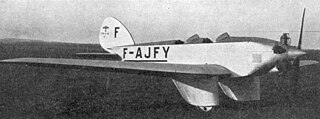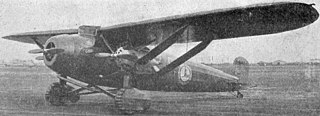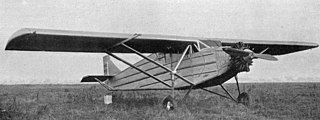| Albert A-20 | |
|---|---|
 | |
| Role | Mailplane |
| National origin | France |
| Manufacturer | Avions Albert |
| First flight | November 1929 |
| Number built | 1 |
The Albert A-20 was a French twin-engined monoplane designed for postal work in 1929. Only one was built.
| Albert A-20 | |
|---|---|
 | |
| Role | Mailplane |
| National origin | France |
| Manufacturer | Avions Albert |
| First flight | November 1929 |
| Number built | 1 |
The Albert A-20 was a French twin-engined monoplane designed for postal work in 1929. Only one was built.
The Albert A-20 had a cantilever, one-piece, thick section, high wing with a convex leading edge and a straight, unswept trailing edge, similar to the wings of the Albert TE.1 and Albert A-10. Narrow-chord ailerons occupied all the trailing edge. The wing structure included multiple spruce and plywood box-spars and variable thickness ply skin. [1]
It was powered by two wing-mounted 45 kW (60 hp) Walter NZ 60 five-cylinder radial engines with their mountings enclosed in streamlined aluminium fairings. Fuel tanks were in the wings. [1]
The A-20's fuselage was flat-sided, with a rectangular section throughout, though in plan the extreme nose was rounded as its section decreased. It was wooden, with four longerons and plywood skin. The cockpit was under the wing with a windscreen at the leading edge providing good views ahead and below. There were two side-by-side seats with opening side-windows, the pilot on the left and navigator on the right. A windowed starboard-side door gave access both to the cockpit and to an under-wing cabin behind the crew which could accommodate two passengers or 150 kg (330 lb) of mail. It was lit by a large window opposite the door. [1]
Like the wing, the empennage was wood framed and ply covered. In plan the horizontal tail was roughly elliptical, with an in-flight adjustable tailplane and single-piece elevator. The fin had a quadrantal profile and carried a near-semicircular unbalanced rudder. [1]
The A-20 had fixed, conventional landing gear, with a track of 3.18 m (10 ft 5 in). Each mainwheel, fitted with a brake, was on a V-strut hinged from the lower longeron, almost horizontal on the ground, with a long oleo strut to the upper longeron. The tailskid was a steel spring. [1]
The exact date of the A-20's first flight is not known but several flights had been made by early December 1929, piloted by both Edouard Albert and Vancaudenberg. They reported a stable and well-behaved aircraft. [1] Despite this, only one was built [2] and there are no new reports on the A-20 beyond 1929 in the contemporary French literature.
Data from Les Ailes, December 1929 [1] Performance figures calculated.
General characteristics
Performance
The Koolhoven F.K.42 was a parasol-wing, two-seat training monoplane manufactured by Koolhoven in the Netherlands. Only one was built.

The Pander E was the first indigenous Dutch training aircraft, used by clubs and also privately owned. A two-seat, single-engine biplane, 17 were built in the Netherlands from 1926 with engines of increasing power.

The Müller G.M.G. II was a German single engine, tandem seat sports monoplane from 1928. Its high wing was unusually mounted.

The Potez 31 was a prototype French two-seat night fighter, flown in about 1928, intended to fill the Cn.2 specification for the Armee de l'Air. Only one was built.
The Potez 38 was a French single engine, eight or nine seat passenger aircraft flown in 1930. Only one was built.
The Caudron C.220 was a two-seat French biplane trainer. Only two were built, using different engines.

The Albert A-60 was a single engine, two seat, wooden sports monoplane designed and built in France in the early 1930s. Two were built and flown with three different engines.
The Dupuy D-40 was a French built, low powered monoplane designed for touring abroad. The only example was used for an uncompleted journey to Saigon.
The Potez 51 was a 1930s French intermediate trainer, intended to replace the ageing Potez 25 which had sold worldwide. It did not go into production.
The SEA.1 was a Belgian, multi-purpose, light twin engine monoplane flown in 1936. Only one was built; it was later converted into a single engine aircraft and used by the military.
The Régnier 12 was a 1930s Belgian touring aircraft offering variants with different engines and seating plans. Only one was built.

The Emsco B-2 Challenger was a US three-engined, six passenger aircraft flown in 1929. Only two were built and they were quite soon converted into two different Emsco types, one with one engine and the other with two.

The Nieuport-Delage NiD 740 was a French trimotor monoplane designed to carry night mail. Two were built in 1930.

The CAMS 52 was a twin-engined floatplane torpedo-bomber. It was not ordered by the French Navy and only one CAMS 52 was completed. It first flew in the summer of 1930.

The Couzinet 20 was a low power, three-engined aircraft designed in France in 1929 for postal duties, though it could have been configured to carry three passengers or as a medical transport. Variants flew with three different engines but only two airframes were completed.

The Magni PM.2 Vittoria was an Italian experimental, single seat, parasol wing aircraft built in the mid-1920s. It had a large area aerofoil on each of its single wing bracing struts which could be rotated together or independently to give lift or drag.

The Hanriot H.25 was a French, single-engined, six passenger airliner built in 1926. Only one was flown.

The Aviaméta 92 was a French, all-metal, five seat monoplane built in the late 1920s. Three different engines were fitted, and one example flew the first non-stop Paris-Algiers flight in preparation for an abandoned trans-Atlantic attempt.

The Albert A-10 was a four-seat French transport aircraft which could be rapidly converted into an air ambulance. Two or three examples were built between 1929 and 1932, using at least two different engines, but neither variant reached production.

The Wallace Touroplane was a late 1920s U.S. three seat, high wing cabin monoplane. About 20 were built.
| Wikimedia Commons has media related to Albert A-20 . |